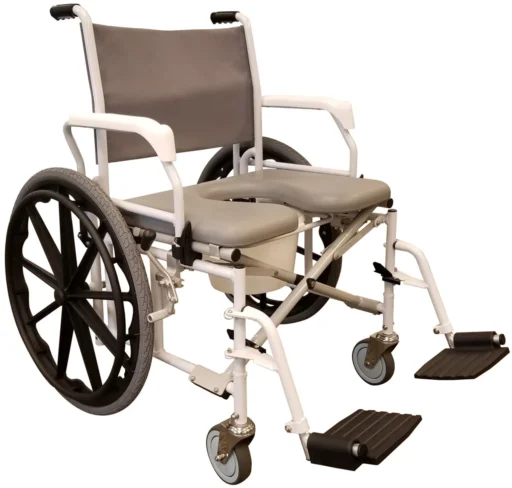It’s a simple, universal truth: personal comfort and independence matter. For many, a standard wheelchair provides the gift of mobility. But when the need for a bathroom arises, that independence can suddenly feel fragile. Transferring to a separate commode or toilet can be a difficult, exhausting, and sometimes risky endeavor. This is where a commode wheelchair isn’t just a piece of medical equipment—it’s a key to dignity, a tool for self-reliance, and a significant relief for both users and caregivers. These ingenious devices integrate a toilet function directly into the chair, elegantly solving a complex daily challenge.
Let’s walk through the different types of commode wheelchairs available, helping you understand which design might be the best fit for your life.
Understanding the Core Design of a Commode Wheelchair
At its heart, a commode wheelchair looks much like a standard model, but with one crucial difference: the seat. Instead of a solid seat, it features a hole in the center, under which a removable bucket or pan is placed. The upholstery is designed to be easily moved aside, and many models come with flip-back or removable armrests to make lateral transfers from a bed or sofa much smoother. It’s a straightforward concept with profound implications for daily living.
A Look at the Different Types of Commode Wheelchairs
Not all needs are the same, and thankfully, neither are these chairs. From basic manual models to specialized designs for specific environments, the market offers a solution for nearly every situation.
The Standard Commode Wheelchair
Think of this as the reliable workhorse. A standard commode wheelchair offers the essential functions without complex extras. It typically features a sturdy steel frame, four wheels (two large for self-propelling and two smaller front casters), and a commode opening with a bucket. The armrests and footrests are often removable or flip-up, facilitating easier transfers.
- Best for: Individuals who need a straightforward, cost-effective solution for occasional toileting use and general mobility around the home.
The Drop-Arm Commode Wheelchair
This design is a game-changer for transfers. The key feature is armrests that can be lowered or swung completely out of the way. Why does this matter? It dramatically reduces the distance and effort needed to slide from a bed or car seat directly into the wheelchair. For users with significant upper body weakness or for caregivers assisting with the transfer, this feature is invaluable.
- Best for: Those who find lateral transfers challenging and need a clear, unobstructed path into and out of the chair.
The Bariatric Commode Wheelchair
Strength, stability, and space are the hallmarks of a bariatric chair. These models are engineered with reinforced frames, heavy-duty components, and wider seats to support higher weight capacities safely. They provide the same commode functionality but are built to ensure durability and user confidence, offering peace of mind alongside physical support.
- Best for: Plus-sized individuals who require a robust and wider wheelchair that doesn’t compromise on the integrated commode feature.
The Tilt-in-Space Commode Wheelchair
This is where clinical need meets sophisticated design. Instead of just tilting the backrest (reclining), a tilt-in-space chair moves the entire seat and backrest as a single unit, preserving the user’s hip and knee angles. This is critical for pressure relief, helping to prevent painful and dangerous pressure sores. It also aids in positioning for those with high muscle tone or postural instability. When you combine this therapeutic function with a built-in commode, you get a chair that supports health in multiple ways.
- Best for: Individuals who spend long hours in the chair and are at risk of skin breakdown, or those who need dynamic positioning for comfort and postural support.
The Shower and Toilet Commode Wheelchair
Why have two chairs when one can do it all? Made from corrosion-resistant materials like aluminum or coated steel, these wheelchairs are built for wet environments. They often feature waterproof seats, drainage holes in the frame and seat, and non-marking, non-slip wheels. You can use them as a commode chair by day and then wheel them directly into the shower, making hygiene routines seamless and reducing the number of transfers required.
- Best for: Creating a continuous, safe routine for bathing and toileting, especially in bathrooms with limited space.
The Pediatric Commode Wheelchair
Children have unique needs, and their equipment should reflect that. Pediatric commode wheelchairs are scaled-down versions with smaller seat dimensions, adjustable components to grow with the child, and often brighter, more engaging colors. They provide the same independence and dignity to young users, helping them navigate their world with greater confidence.
- Best for: Children and smaller-framed users who require a properly sized chair for both mobility and toileting.
The Electric Commode Wheelchair
For those with limited arm strength or dexterity, an electric commode wheelchair offers the ultimate independence. Powered by a rechargeable battery and controlled via a simple joystick or other adaptive control, these chairs restore the power of self-propelled mobility without physical strain. The integration of a commode means a user can manage their entire day without needing assistance for movement or bathroom breaks.
- Best for: Individuals who cannot self-propel a manual chair but desire a high degree of autonomy in their daily routine.
Making Your Choice: It’s More Than Just a Chair
Selecting the right commode wheelchair is a deeply personal decision. It’s not just about specifications; it’s about how the chair fits into a life. Consider the primary environment—will it be used mostly at home or will it travel? Think about the user’s physical needs, weight, and height. Most importantly, consult with an occupational therapist or a medical equipment specialist. They can provide a professional assessment to ensure the chair supports the user’s health and mobility goals safely.
Your Partner in Mobility and Independence
Navigating the world of medical equipment can feel overwhelming. You want a partner who understands that a wheelchair isn’t just a product—it’s a vital part of someone’s daily life. At Marium Oxygen, while we are widely recognized for our reliable oxygen cylinders and concentrators, our commitment extends to supporting overall patient care with a curated selection of essential mobility aids and wheelchairs.
We believe that understanding your options is the first step toward making a confident decision. Whether a standard model meets your needs or a specialized tilt-in-space chair is required, the right commode wheelchair is out there, waiting to give you back a little more control and a lot more comfort.






